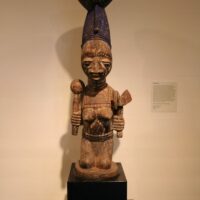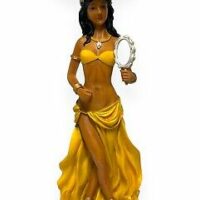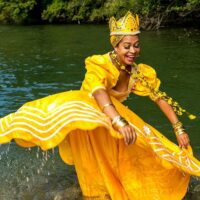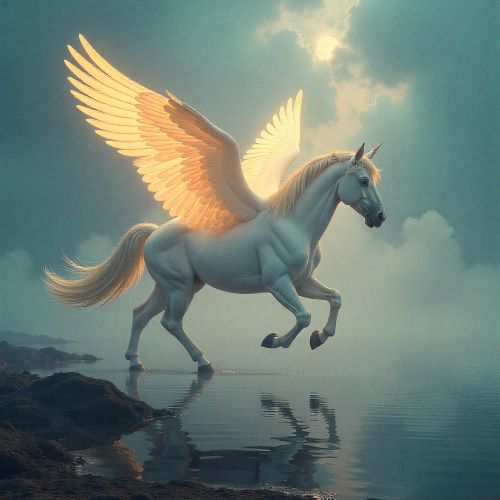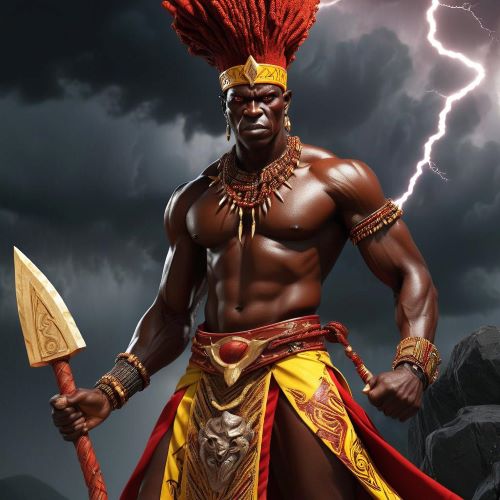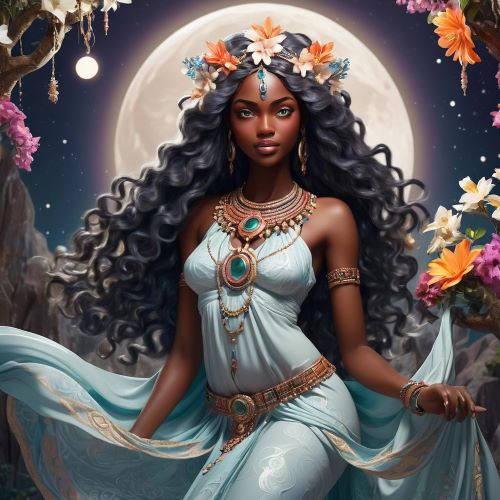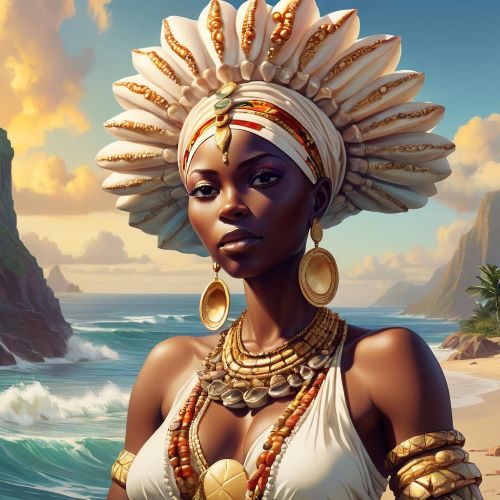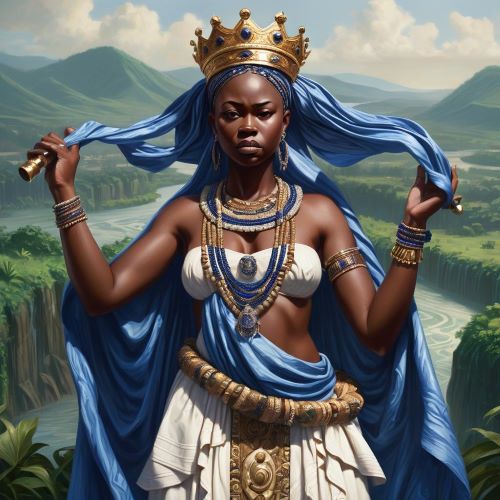Oshun : Goddess of Love
Listen
At a glance
| Description | |
|---|---|
| Origin | Yoruba Mythology |
| Classification | Gods |
| Family Members | Yemoja (Mother), Shango (Husband) |
| Region | Nigeria |
| Associated With | Love, Fertility, Rivers |
Oshun
Introduction
Oshun is one of the most cherished and powerful orishas in Yoruba mythology. Originating among the Yoruba people of southwestern Nigeria, Oshun’s presence has rippled through time and space, carried across oceans by the African diaspora. Revered as the orisha of fresh water, fertility, love, and sensuality, she holds a place of vital importance within the Yoruba religious tradition. More than just a deity of beauty and emotion, Oshun is a life-giver and protector, often portrayed as the essential feminine force without which creation itself could not flourish. In one of the most well-known Yoruba creation myths, Oshun is the only female orisha among a group sent to Earth to bring forth life. When the others failed, her intervention—through the healing power of water—restored the world, emphasizing that divine balance cannot exist without feminine energy.
Physical Traits
Oshun is visually celebrated for her elegance, grace, and radiant beauty. Artistic depictions often show her adorned in golden or yellow fabrics that reflect her joyful essence and her association with wealth and purity. Her golden skin and shimmering attire are matched by her love for ornate accessories—mirrors, brass bracelets, beads, and elaborate fans are some of the sacred objects linked to her image. Each item carries symbolic meaning: mirrors for self-reflection, honey for sweetness, and peacocks for transformation and pride.
At times, Oshun is portrayed as a mermaid or as a figure with aquatic features, underscoring her dominion over rivers and streams. She’s also linked to animals like otters, butterflies, and bees, each representing qualities such as joy, fertility, change, and self-reliance. Her sacred colors—gold, yellow, and coral—speak to her connection with life’s sweetness and the abundance of nature.
Family
Within the Orisha pantheon, Oshun is considered to be one of the youngest deities, though her wisdom and influence are profound. She is often described as either the daughter or younger sister of Yemoja, the ocean goddess who represents motherhood. Together, the two form a symbolic duality—Yemoja governs the vast ocean, while Oshun reigns over the rivers, signifying a flowing relationship between motherhood and sensuality, depth and movement.
Oshun’s romantic ties are also notable. She is widely recognized as one of the wives of Shango, the orisha of thunder and lightning. Their relationship represents a dynamic blend of power and passion, a union of elemental forces. Some traditions also mention her as a consort to other orishas, further emphasizing her emotional and diplomatic importance within the divine family structure. Through these connections, Oshun plays a crucial role in harmonizing the energies of creation, strength, and compassion.
Other Names
Oshun’s worship spread across the globe, particularly through the transatlantic slave trade, and her name evolved in different cultures and languages. In Cuba’s Santería, she is called Ochún; in Brazil’s Candomblé, she is Oxúm; and in Haitian Vodou, she is often syncretized with Erzulie, another spirit of love and beauty. Among Catholic traditions, Oshun is linked to Our Lady of Charity, a representation of divine care and maternal protection.
She is also known by titles such as Yeye Oshun (Mother Oshun), Lady of Gold, and Oshun Yeye Kari (Mother of Sweetness). These titles reflect her multi-faceted nature: tender yet fierce, nurturing yet powerful. Her adaptability and resilience across cultures speak to her enduring spiritual influence.
Powers and Abilities
Oshun’s powers are rooted in both the physical and spiritual realms. As the orisha of love and sensuality, she governs the domains of romance, desire, and emotional healing. Women call upon her for guidance in relationships, for fertility blessings, and for assistance in childbirth. She is also the patron of music, dance, and artistic expression—elements that uplift the soul and connect people to joy and beauty.
Her dominion over rivers and fresh water makes her a life-sustainer. She nourishes the earth, feeds the crops, and brings balance to ecosystems. But Oshun’s waters are not only healing—they can also be destructive when disrespected. If angered or neglected, she can bring about floods or withhold her blessings, reminding us of nature’s duality.
Oshun’s spiritual gifts also include divination and magic. She teaches the use of cowrie shells for spiritual insight and helps her devotees learn self-care, self-love, and emotional strength. Her wisdom is often sought in difficult times, especially when emotional or physical healing is needed.
Modern Day Influences
Today, Oshun’s legacy continues to thrive both in religious practices and popular culture. In Nigeria, the Osun-Osogbo Festival is a grand annual event held in her honor. Taking place in the sacred Osun-Osogbo Grove, a UNESCO World Heritage site, the festival draws thousands of pilgrims and tourists who come to pay homage and seek blessings. This lush forest sanctuary, filled with shrines and sculptures, is believed to be fiercely protected by Oshun herself, who granted humans permission to settle there in exchange for worship and reverence.
Across the Americas, especially in Cuba and Brazil, Oshun is a key figure in Afro-Caribbean spiritual traditions. In Santería and Candomblé, devotees offer honey, oranges, cinnamon, and other sweet gifts to appease and honor her. Songs, dances, and drumming ceremonies call upon her loving energy, often invoking her as a maternal protector and life-giver.
Her image has also found a place in modern art, music, and social commentary. Beyoncé’s homage to Oshun in the “Hold Up” music video—walking through water in a flowing yellow dress—sparked global conversations about Black femininity, ancestral power, and healing. Artists, writers, and activists continue to draw inspiration from Oshun’s qualities, using her symbolism to express themes of beauty, resilience, and divine feminine strength.
In feminist circles, especially within Afrocentric movements, Oshun has become a powerful icon of womanhood. Her connection to both sensuality and emotional intelligence resonates with modern conversations about gender, identity, and empowerment. For many, invoking Oshun is an act of reclaiming cultural heritage and embracing inner power.
Related Images
Source
Britannica. (n.d.). Oshun Yoruba Goddess of Love, Fertility & Abundance. Retrieved from https://www.britannica.com/topic/Oshun
Jeffries, B. S. (n.d.). Oshun. In Encyclopaedia Britannica. Retrieved from https://www.britannica.com/topic/Oshun
Botanica Online. (n.d.). A Comprehensive Guide to Oshun, the Goddess of Love and Beauty. Retrieved from https://botanicaonline.net/blogs/yoruba/oshun-the-goddess-of-love-and-beauty
Wikipedia contributors. (n.d.). Oshun. In Wikipedia, The Free Encyclopedia. Retrieved from https://en.wikipedia.org/wiki/Oshun
Frequently Asked Questions
What is lorem Ipsum?
I am text block. Click edit button to change this text. Lorem ipsum dolor sit amet, consectetur adipiscing elit. Ut elit tellus, luctus nec ullamcorper mattis, pulvinar dapibus leo.
What is lorem Ipsum?
I am text block. Click edit button to change this text. Lorem ipsum dolor sit amet, consectetur adipiscing elit. Ut elit tellus, luctus nec ullamcorper mattis, pulvinar dapibus leo.
What is lorem Ipsum?
I am text block. Click edit button to change this text. Lorem ipsum dolor sit amet, consectetur adipiscing elit. Ut elit tellus, luctus nec ullamcorper mattis, pulvinar dapibus leo.
What is lorem Ipsum?
I am text block. Click edit button to change this text. Lorem ipsum dolor sit amet, consectetur adipiscing elit. Ut elit tellus, luctus nec ullamcorper mattis, pulvinar dapibus leo.
What is lorem Ipsum?
I am text block. Click edit button to change this text. Lorem ipsum dolor sit amet, consectetur adipiscing elit. Ut elit tellus, luctus nec ullamcorper mattis, pulvinar dapibus leo.



